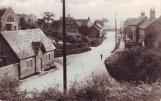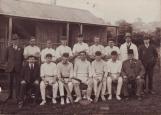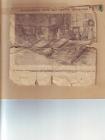1
Tom Hulme decorating mixing bowl20th century, Circa 1947
Medalta Potteries Limited, Medicine Hat, Alberta, Canada
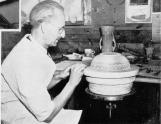
2
It was 1929. Medalta was doing well. The owners wanted to expand their production to include art ware. Jessie William (Bill) Wyatt, the plant superintendent, already had his hands full overseeing the entire plant. So, he had an art room built in Building 13, set up a new department to handle the decorating and hired Tom Hulme to manage it.4
Tom Hulme was born in Blackfordby, England on October 23, 1892, the youngest child of Thomas and Mary Ann Hulme. He grew up with two sisters, Gert and Mary, and one step-brother, Sam, in an area not far from Stoke-on-Trent , the city often referred to as "The Potteries" from which Wedgewood, Royal Doulton, Spode, Minton and other well-known china originated.6
The proximity of the ceramic factories and Tom's artistic bent were probably the reasons his father apprenticed Tom to a local pottery when he was sixteen. For the next 6 years, he swept a lot of floors, performed a myriad of menial tasks, wrote numerous exams and learned the craft.8
While he was apprenticing, he attended night school at the Royal Academy and studied painting. As part of the curriculum, Tom and his fellow students spent many hours at the art gallery with their easels set up in front of works by the Masters, trying to make faithful copies of them. This was one of the standard methods of teaching art. The very formal, some might consider rigid, structure of Tom's training in ceramics and painting forever influenced his approach to his work and to his personal endeavours.10
The First World War came along and he enlisted, serving in England and with the occupation forces on the continent until 1920. Tom found the latter extremely difficult, having to deal with the corpses of fallen soldiers.After the war, he returned to Blackfordby where he taught drawing, painting and ceramics with the Association of Homecrafts Studios, Ltd. of which he was a member.
12
It is unclear why he left his home in England, to cross the Atlantic Ocean, and travel thousands of miles to a small prairie town . He may have come to seek a position in the art department at the University of Alberta, Edmonton, only to be told that he would need to re-qualify. Or he could have been called over to Canada by Bill Wyatt, in whose house he stayed when he initially arrived.In any event, Tom came to Medicine Hat, Alberta, Canada in 1929 to take the helm as head of the decorating department for Medalta Potteries.
13
Handpainted jardiniere20th Century, Circa 1930's - 1940's
Medicine Hat, Alberta, Canada
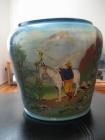 Credits:
Credits:Tom Hulme
14
He had the ideal background for this position. His rigourous training in ceramics and painting well prepared him for his duties. If anything, he was likely over qualified for the job. In a pottery factory that was mass producing fairly utilitarian goods, his vast knowledge was not fully utilised. However, it may have been exactly that thorough early training that both Tom and Bill received in England, that gave Medalta the ability to meet the demand of ever changing consumer tastes by constantly introducing new designs, whether their own or knock-offs of pieces from American catalogues or suggested salesmen samples.Variety in the art ware was achieved by a number of methods. Lamp bases, vases and flower containers were slip cast in many different shapes. Surfaces were treated with multi-coloured glazes. Some were hand painted with ships, sailboats, windmills, cottages, and nomads on camels. Some had surfaces embossed with images like a little Dutch boy and girl, an Indian brave and maiden, a bird flying over a lily pad or a fierce dragon. Still other patterns were created using stencils, decals, air brushing or stamps. Some images combined several of the methods.
In the early years at Medalta Potteries, much of the hand painting on the ware was done by Tom himself. For lead foil stencils and stamps, he made the original drawings and designs. Until the advent of the Second World War, most of the decals were ordered from England.
